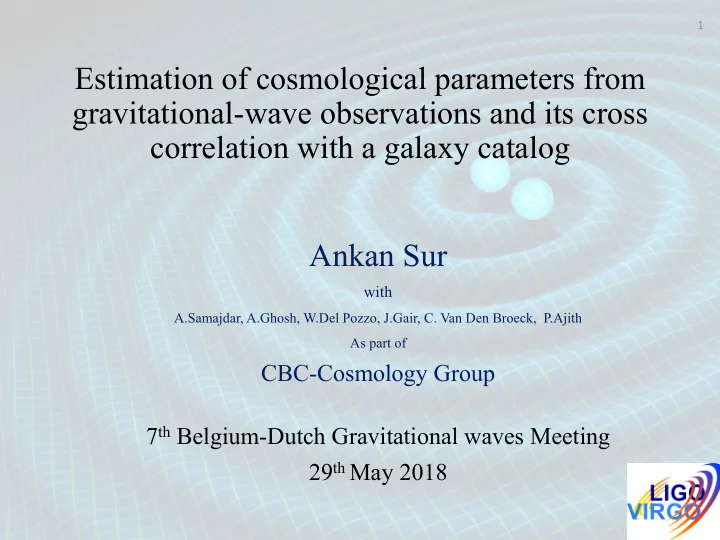

1 Estimation of cosmological parameters from gravitational-wave observations and its cross correlation with a galaxy catalog Ankan Sur with A.Samajdar, A.Ghosh, W.Del Pozzo, J.Gair, C. Van Den Broeck, P.Ajith As part of CBC-Cosmology Group 7 th Belgium-Dutch Gravitational waves Meeting 29 th May 2018
Measuring Hubble’s Constant 2 Ø Plot velocity along y-axis and distance along x-axis Ø Get the best fit 𝑤 𝑠𝑓𝑑 = 𝑨𝑑 = H 0 D L (in local universe) Slope = H 0 Important parameter in cosmology! PNAS March 15, 1929. 15 (3) 168-173
Cosmic Distance Ladder Standard Candles 3 200 Mpc Tully Fisher Relation 25 Mpc Cepheids Main sequence fitting 10 Mpc 10 kpc parallax 100 pc
Gravitational Waves 4 Ø Detected by LIGO and VIRGO ⁄ ℎ(𝑢)~ 𝑁 2 3 𝐸 6 Credit:LIGO Caltech Ø Phase = Chirp Mass Ø Strain = D L Standard Sirens! PRL 116, 061102 (2016)
Motivation: 5 GW170817 + Electromagnetic counterpart = redshift From https://www.ligo.org/
First standard siren measurement of H 0 6 Nature 551,8588 (02 November 2017)
Convergence Plot 7 Nissanke et al (ArXiv:1307.2638 )
� �� � Statistical Approach 8 Ø In the absence of transient EM counterpart, we use information present in a galaxy catalog. Ø Take into account: § GW selection effects: detectors can only detect above a certain signal to noise ratio ( ρ th = 8.0) § EM selection effects: Use Schechter magnitude function to account for missing galaxies. Ø Use Bayesian analysis § 𝑄 𝛻|𝜁 = ; <|= ; = ; < flat prior on 𝐼 0 @ A @ @ B ∑ 𝑥 𝑝 𝑞 𝐸 𝑀 𝑨 𝑝 , 𝛻 @ B ∫ 𝑒𝑨𝑒𝑁 𝑞 𝜁|𝑁, 𝑨, 𝛻 𝜚 𝑁 𝛪 𝑛 𝑁, 𝑨, 𝛻 − 𝑛𝑢ℎ 𝑞(𝑨| Ø 𝑞 ε 𝛻 = + 𝛻 ) I Information from catalog Term accounting for missing information in the catalog
Statistical Approach 9 Ø applicable to sources without counterparts and even binary black hole coalescences. Ø Combining information across events is crucial for measurement of H 0 be it the counterpart or the statistical approach. Understanding systematic effects is important, since even small systematic effects can get amplified over statistical errors while combining information from multiple events. From: Del Pozzo, Phys. Rev. D 86 , 043011
10 Results Mock galaxy catalog (Gray et al. in preparation) Ø Simulations carried for binary neutron stars Ø 250 sources Ø Maximum redshift = 0.4 Ø Catalog complete up to 𝑨 = 0.1 (distance = 435.5 Mpc) Combined posterior on H 0
Conclusions and future directions 11 Ø H 0 can be statistically measured. Ø Extend our analysis to determine other cosmological parameters. Ø More luminous galaxies have higher probability of hosting GW sources. Ø Account for redshift uncertainties in our analysis.
Recommend
More recommend